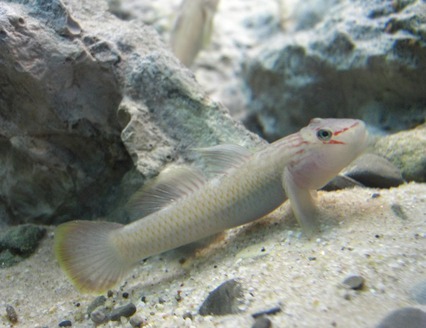Matt Clarke explains how to keep and breed the Rhinogobius candidianus.
Scientific name: Rhinogobius candidianus (Regan, 1908).
Origin: Endemic to north-eastern and north-central parts of the island of Taiwan and occurring in several rivers, including the Joshuei, Shuanshi, Marlian, Parlian, Tamshuei, Holong, Jongkang, Darchia and Tatu.
Although Regan apparently described the species from Lake Candidius (Sun Moon Lake), it is reportedly only found in influent rivers. The only Rhinogobius found in the lake is R. giurinus, which exists in a lacustrine (lake-dwelling) form.

Size: Males can reach around 8cm/3.1”, females are a shade smaller.
Water: They enjoy moderately alkaline water. It must be well oxygenated and free of pollution. As coldwater fish they should be kept at temperatures between 14-20C/57-68°F, though mine are breeding and doing well at 25°C/77°F.
Diet: Mine readily accept catfish tablets, as well as frozen bloodworms and brineshrimp.
Aquarium: These gobies are found in cool, fast-flowing mountain rivers and streams and look great in a biotope tank. Go for one of at least 60cm/24”. Furnish it with a mix of sand and gravel to aid digging and scatter the bottom with a layer of rocks, pebbles and bits of driftwood. Use an over-sized power filter or add additional flow pumps as these fish love flow and use the current while spawning. No heater is required.
If you don’t want a biotope keep them in a community tank, though you must ensure the water is well oxygenated and the temperature does not rise too high as they’re really a sub-tropical fish. They’re peaceful around other species and mix well, but will be territorial with other gobies, particularly their own kind.
Don’t add too many and a pair would need at least that 60cm/ 24” tank.

Sexing: Males are larger, more colourful and have elongate dorsal fins. Females are shorter, stockier and have rounded fins. They also develop dark abdomens when in spawning condition.
Breeding: I’ve recently seen my candidianus spawning. The pair rise to the surface and rub and flap against each other where flow is most torrential. In nature males act the same way to show off to females, so powerful filters and extra flow pumps are advisable.
During courtship the male frequently bites the female’s flanks and she may suffer body and fin damage, though this heals quickly. The pair will retreat to a secluded cave among rocks or bogwood and may excavate a pit around the site. After laying the eggs the female will be evicted and the male may not be seen for a week or more while he guards the brood.
I’ve not yet raised the eggs from mine, so cannot comment on how tricky the fry are to raise.

Identification: Rhinogobius are difficult to identify. This fish pictured was imported as R. gigas, but I’m not convinced they are this species. The fish is of the Rhinogobius brunneus complex which includes more than eight species, including candidianus, nagoyae formosanus, rubromaculatus, gigas, nantaiensis, delicates, maculafasciatus and henchuenensis.
Rhinogobius candidianus, R. giurinus and R. nagoyae formosanus are all now on sale in the shops and all are found in the Peishi area of Taiwan.
R. gigas is found in rivers along the eastern coast of Taiwan and while it is possible collectors might be fishing there too it seems more logical that they’ve misidentified candidianus as gigas. The fin rays I’ve counted on fish imported as gigas also seem to suggest they’re actually candidianus.
Availability: The fish are fairly uncommon and available only sporadically in a number of specialist shops. These were on sale as Rhinogobius gigas at Wildwoods.
Price: Expect to pay £10 per fish.







